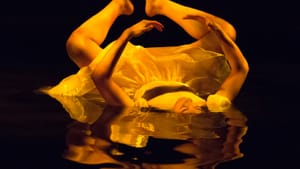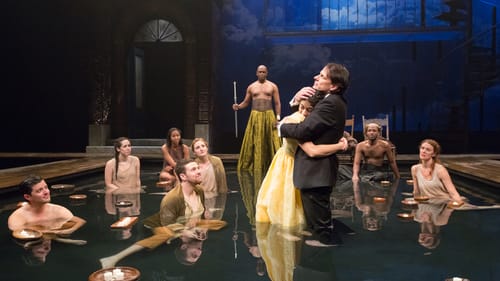Stay in the Loop
BSR publishes on a weekly schedule, with an email newsletter every Wednesday and Thursday morning. There’s no paywall, and subscribing is always free.
Lessons about love from long ago, and a swimming pool
Mary Zimmerman's 'Metamorphoses' at the Arden (second review)

“Myths are the earliest form of science,” says one of the narrators in Mary Zimmerman’s Metamorphoses at the Arden Theatre — meaning, I suppose, that they explain the way things are. Another says that “Myths are public dreams, dreams are private myths,” implying that there are some things science just can’t know. Metamorphoses is based on the myths collected by the Roman poet Ovid, just as the Grimm Brothers collected the fairy tales that were a part of our childhoods. Zimmerman, basing her adaptation on the free-verse translation of Ovid by David R. Slavitt, has selected only a few of Ovid’s 250 myths, while hinting at others. As with fairy tales, these can be both charming stories and deeper psychological explorations of human behavior.
The play, directed by Doug Hara, is set around and in a pool of water into which the characters wade, plunge, and submerge with little regard for their costumes, which seem to dry miraculously between scenes (the actors dry off and change between appearances). It is a mystical, magical set designed by Brian Sidney Bembridge, with gods appearing on a platform above the stage and sometimes descending to woo or test the humans who dare to challenge their rule. A chandelier sparkles above the scene and eventually candles float on the water in lighting design by Thom Weaver.
Some of the stories are familiar: Midas (Christopher Patrick Mullen) and his golden touch, which turns his daughter (Leigha Kato) to gold; Orpheus (Sean Bradley) pining for Eurydice (Clare O’Malley), who is lost to him because he dared to look too soon. Some are not: Vertumnus (Brandon Pierce) wooing the nymph Pomona (Alex Keiper), Erysichthon (Lindsay Smiling) daring to cut down a tree sacred to Ceres and suffering from excruciating hunger as a result. All surprise us with their relevance even after all these years.
Similarly, there’s a mix of stories with happy endings (which may mean the lovers die simultaneously, or turn into entwined trees or fly off as sea birds) and those without (Orpheus never does rejoin Eurydice). Themes start to emerge about vulnerability in love or the dangers of looking too closely at love.
The play is structured around a series of storytellers, each recounting a myth to someone else as actors portray the characters, sometimes speaking, sometimes not. The company functions as an ensemble, with most actors taking on several roles. The narrators move the story along, often explaining the meaning of the myth rather than letting it carry its own message. While the production as a whole is engaging, the acting sometimes feels stilted — perhaps being submerged in water is not the best environment for dramatic performance.
There seemed to be more possibilities for humor than emerged in the production. The character’s absurd actions are taken a bit too seriously, although the audience was willing to laugh when given the opportunity.
Staging that’s all wet
This is a captivating production, but what’s with all this water on stage? I know water is supposed to be a metaphor for the subconscious, but must it always be this literal? Phaeton (Steve Pacek) sitting on a float in the middle of the water talking to his therapist about his relationship with his father Apollo was more than obvious. Toy ships capsize in a storm, while other characters seem to literally drown in the pool, emerging when the lights dim.

In the past year and more there have been several productions that highlight the use of water: Water by the Spoonful at the Arden had streams of water running across the stage, Ivo van Hove’s Bergman-based After the Rehearsal/Persona as part of the 2015 Fringe Festival surrounded the stage with water, and Theatre Exile’s Red Speedo (which I did not see) had a swimming pool on stage. Inis Nua Theatre Company’s Penelope took place in and around a dry swimming pool, and The Hairy Ape at EgoPo Classic Theater had buckets of water pouring down on the actors.
Water on stage is one of those unnatural cohabitations, and that is perhaps part of its fascination. Things can happen on water that can’t on dry land — at least not without injury to the performers. As environment and physical performance become integral to play production, actors are challenged to not only find the truth in a character but also to cope with environmental challenges posed by the set. Are we demanding new and different at the expense of depth and authenticity?
For Frank Burd’s review, click here.
What, When, Where
Metamorphoses by Mary Zimmerman. Based on the myths of Ovid. Doug Hara directed. Through November 1, 2015 on the F. Otto Haas Stage at Arden Theatre Company, 40 N. 2nd Street, Philadelphia. ardentheatre.org or 215-922-1122.
Sign up for our newsletter
All of the week's new articles, all in one place. Sign up for the free weekly BSR newsletters, and don't miss a conversation.

 Naomi Orwin
Naomi Orwin